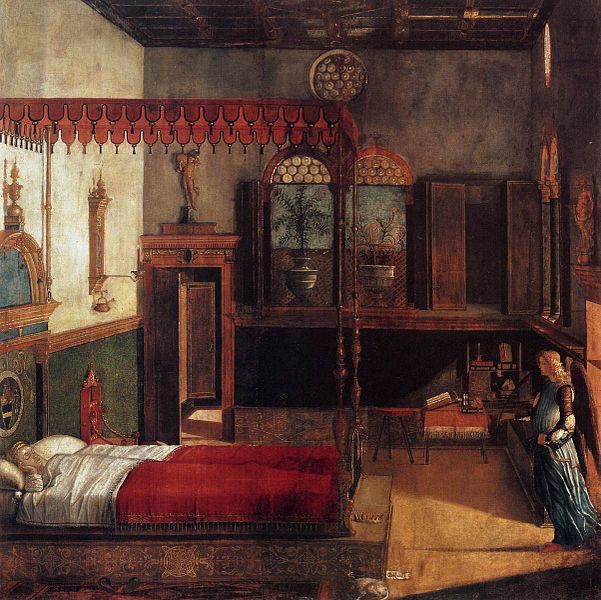Vittore Carpaccio, The Dream of Saint Ursula, 1495
Vittore Carpaccio (c1465-1525/6) was a Venetian painter of the Italian Renaissance. This scene is from Carpaccio's most series of paintings, The Legend of Saint Ursula. The story is derived from Jacopo da Varagine's Golden Legend, a seminal text of the period, which is still an important source for many stories about the saints. Ursula was a Christian princess of Brittany who, while returning from pilgrimage to Rome, was killed by the leader of the Huns for refusing to marry him. (Some sources say it was Attila but Ursula would have lived over fifty years before his rule.) Ursula is said to have been martyred along with 10,000 virgin handmaidens. In this scene, an angel comes to inform Ursula of her impending martyrdom. Among the many interesting features of this painting is the successful use of linear perspective. It was still a fairly new invention at the time and Carpaccio was very effective in communicating the depth and space of the room; the open doorway on the far wall is a prime example. This effect is also aided by Carpaccio's use of light. The two doorways both let light into the room and the trajectories of the light realistically convey the space. Ursula and her bed are lighted by the doorway that the angel stands in, while the opposite corner remains in shadow. There is also fascinating realism in the rendering of the walls and ceiling; Carpaccio's brushwork gives a strong sense of texture. This particular effect is reminiscent of the painting of Northern Europe, particularly the Netherlands, which had made its way into Italy and was a particular influence on Carpaccio. I am taken by the calm energy of the piece and the many beautiful details of the room. Much of the Saint Ursula series is made up of large crowd scenes, which are depicted quite skillfully and are striking in their intricacy and in contrast the simplicity of this painting is quite moving.

canadian holidays 2018 ontario
ReplyDeletecanadian holidays 2019
statutory holidays ontario
holidays in canada
civic holiday
canada day 2018
quebec holidays 2018
What are the Canadian holidays for 2018?
holi bhai dooj 2018
ReplyDeletebhai dooj 2018 after holi
diwali bhai dooj 2018
bhai dooj messages
holi bhai dooj 2018 date
bhai dooj images
bhai dooj 2018 muhurat
bhai dooj 2017